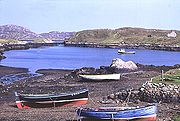
Ronay
Encyclopedia

Island
An island or isle is any piece of sub-continental land that is surrounded by water. Very small islands such as emergent land features on atolls can be called islets, cays or keys. An island in a river or lake may be called an eyot , or holm...
in the Outer Hebrides
Outer Hebrides
The Outer Hebrides also known as the Western Isles and the Long Island, is an island chain off the west coast of Scotland. The islands are geographically contiguous with Comhairle nan Eilean Siar, one of the 32 unitary council areas of Scotland...
of Scotland
Scotland
Scotland is a country that is part of the United Kingdom. Occupying the northern third of the island of Great Britain, it shares a border with England to the south and is bounded by the North Sea to the east, the Atlantic Ocean to the north and west, and the North Channel and Irish Sea to the...
, which lies a short distance off the east coast of Grimsay
Grimsay
Grimsay is a tidal island in the Outer Hebrides of Scotland.Grimsay is the largest of the low-lying stepping-stones which convey the Oitir Mhòr causeway, a five mile arc of single track road linking North Uist and Benbecula via the western tip of Grimsay...
.
Geography
Ronay has a highly indented coastline with Bàgh nan Uamh being the biggest up in the north west. The island is surrounded by many smaller ones including Eilean na Cloiche in the south east, Eilean an Fhèidh in the east, Flodaigh MòrFlodaigh Mòr
Flodaigh Mòr is an uninhabited island in the Outer Hebrides of Scotland.-Geography and geology:Flodaigh Mòr lies east of North Uist, close offshore to Ronay. It contains a large freshwater loch . The eastern headland is almost detached. To the north, skerries almost connect to...
in the north east, Haunaray to the north, and Garbh Eilean Mòr between it and Grimsay.
The north forms a peninsula called Rònaigh Beag, or little Ronay. The central section contains some seven or more lochs, which provide a freshwater supply.
The entire island is rough, covered in outcrops and knolls, which may have been partly eroded by overgrazing. There are three main peaks, the Beinn Rodagraich range (99m) in the south, the Beinn a' Chàrnain range in the east (115m) which incorporates Cnoc Mòr and Beinn an t-Sagairt, and the third in Ronaigh Beag, which rises to 74m.
History
Like many Scottish islands, Ronay appears to have ancient Celtic church connections. In the north west, there is a headland (Rubha) and mountain (Beinn) of the priest (an t-sagairt), and a Rubha na Manach (monk's headland) in the south west. Martin MartinMartin Martin
Martin Martin was a Scottish writer best known for his work A Description of the Western Isles of Scotland . This book is particularly noted for its information on the St Kilda archipelago...
also mentions a chapel:
- "in the Island Rona, called the Low-landers Chappel, because Seamen who dye in times of Fishing, are buried in that place."
This chapel was pre-Reformation. It is also possible that the island's name refers to St Ronan, as that of North Rona
North Rona
Rona is a remote Scottish island in the North Atlantic. Rona is often referred to as North Rona in order to distinguish it from South Rona . It has an area of and a maximum height of...
does. In the centre, there are several names related to "Druidhneach" (possibly druid
Druid
A druid was a member of the priestly class in Britain, Ireland, and Gaul, and possibly other parts of Celtic western Europe, during the Iron Age....
s), such as Loch nan Druidhneach. Such names often refer to neolithic remains.
Other historical references occur in the island's names, such as Bàgh Clann Neill in the west, Rubha Creag Mhic Fhionnlaigh and Bàgh na h-Eireannach in the north.
In 1826, there were 180 living on the island, but in 1831, the whole population was cleared to make way for sheep farming. See Highland Clearances
Highland Clearances
The Highland Clearances were forced displacements of the population of the Scottish Highlands during the 18th and 19th centuries. They led to mass emigration to the sea coast, the Scottish Lowlands, and the North American colonies...
. However, by 1841, 9 people were recorded, who may have moved back. The island was abandoned for good in 1931.

